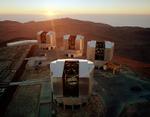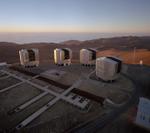With the advent of large and multi-telescope arrays in the past years, interferometry has reached a new stage. Interferometers have become a more common tool for astronomical observations. They have long been team instruments equipped with a few telescopes of small diameter. Because interferometers were limited to bright sources and with no imaging capabilities, only stellar physics have benefited from this instrumental breakthrough. This time is over! Thanks to the use of large telescopes, interferometers now allow to study bright as well as relatively faint objects. First observations of active galactic nuclei have been performed with the Very Large Telescope Interferometer (VLTI) and the Keck interferometric array allowing to study objects which were still point-like until very recently. With the increasingly large number of telescopes, interferometers are on the verge to reconstruct complex images at an unprecedented angular resolution. Interferometric facilities are becoming more and more open to non-specialist astronomers. The VLTI is a very good example. Three instruments have been opened to the astronomical community : VINCI (until 2004), MIDI and AMBER. It is one of the most powerful interferometers with four 8-m telescopes and four 1.8-meter telescopes, the latter being relocatable on the array allowing an extensive number of configurations for high quality imaging. Although it is still the beginning, VLTI is a success with several tens of astrophysical papers already published. Such a powerful tool is very promising for many astrophysical topics and outstanding science is at hand for astronomers who know how to prepare and use such observations.
School objectives
The European Southern Observatory (ESO) in collaboration with many European institutes has operated the VLTI since 2002. Institutes in Europe have teamed-up to build a first generation of instruments which are in use and available through calls for observing proposals. The operation of the first VLTI instruments has allowed to train newcomers to this technique. A second generation of more powerful instruments will be available with still better sensitivities and imaging capabilities. However the scientific outcome will be at the same level as the VLTI performance only if astronomers get prepared to interferometric observations and to the use of interferometric data and if the specialists in interferometry transmit their knowledge to the European astronomical community. With this objective in mind, we organize a summer school to train astronomers to the use of the VLTI current generation of instruments.
The objective of the school, beyond learning the basics of interferometry and getting acquainted to the VLTI instruments, is to get practical training of the most important tools required to prepare interferometric observations and to process the data for astrophysical studies. A first school in 2002 had focused on observation preparation. In this sequel, attendees will in particular be trained to data reduction, model fitting and image reconstruction. The goal is that attendees be autonomous to prepare an observing proposal to use MIDI and AMBER and use the data for their own astrophysical studies.
The curriculum of the school consists in general lectures for 30% of the time, practical training for 50% of it and informal seminars for the remaining of the time. A detailed agenda is available on the school web site. The school will take place over two weeks at the Château de Goutelas in the center of France from June 4 to June 16.
ORGANIZATION
School Chairs
Fabien Malbet (LAOG, Grenoble)
Guy Perrin (Observatoire de Paris, Meudon)
To contact them, please send a message to vltischool@obs.ujf-grenoble.fr
Scientific Organizing Committee
R. Akeson (MSC/Caltech), A. Boden (MSC/Caltech), F. Delplancke (ESO), A. Dutrey (Bordeaux), P. Garcia (Porto), A. Glindemann (ESO), C. Haniff (Cambridge), C. Leinert (MPIA, Heidelberg), B. Lopez (OCA, Nice), R. Petrov (UNSA, Nice), D. Queloz (Genève), J. Surdej (Liège), G. Weigelt (MPIfR, Bonn)
Local Organizing Committee
Myriam Benisty (LAOG), Ginette Buisson (LAOG), Sylvain Cêtre (LAOG), Gilles Duvert (LAOG), Khadidja Fentroucci (LAOG), Paulo Garcia (CAUP), Oscar Hernandez Utrera (LAOG), Sylvain Lafrasse (JMMC/LAOG), Guillaume Mella (JMMC/LAOG), Jean-Luc Menut (OCA), Florentin Millour (LUAN/LAOG), Marie-Rose Ramarao (LESIA), Ludovic Saugé (JMMC/LAOG)
PRACTICAL INFORMATIONS AND REQUESTS
Participants
The list of participants is published on-line
School program
The final program is available on the school website as well as the list of lecturers.
Rooms
Each participant will have a room-mate. Please let us know (write to guy.perrin-at-obspm.fr) if you wish to be with someone in particular and send us an email with Cc to your room-mate.
Leisure and entertainment
Goutelas is located in a lovely area in which walking is quite enjoyable. Do not hesitate to bring your sport or walking shoes. The castle also has a tennis court and you are welcome to bring your own racket and balls. A few sites around Goutelas are quite interesting and we will try to organize visits to these during the week-end (depending on the amount of cars available).
Transportation
A taxi service will be organized to pick-up participants at Boën train station. Please let us know (write to guy.perrin-at-obspm.fr) when you are scheduled to arrive to organize pick-ups. Check the transportation item in the practical information section of the website for more details.
Food
Should you have any food requirement, please tell us soon. We remind that food expenses are covered during the stay in Goutelas.
Practical sessions and computers
25 laptops with all the required softwares will be provided to the participants for practical sessions. Participants are welcome to bring their own laptop. A wifi network will be set-up in the auditorium and in the practice session room.
Posters
You are encouraged to bring a poster to the school to present your work. The typical format is A0 (84 x 118 cm). They will be displayed during the whole duration of the event.
Weather conditions in Goutelas in June
The weather is usually fine in this period of the year in the Goutelas area and maybe a little hot. However, mornings may be a little bit chilly.
Goutelas Address and phone number
CENTRE CULTUREL
CHÂTEAU DE GOUTELAS
42130 MARCOUX
Tél : +33 (0) 4 77 97 35 42
Fax : +33 (0) 4 77 97 31 06
E-mail : goutelas-at-wanadoo.fr










 @
@